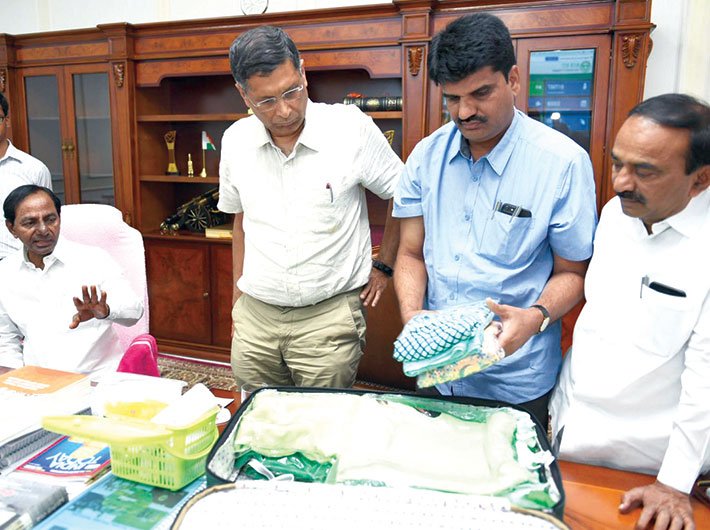In Telangana, when a baby is born, mothers receive a gift hamper from the govt. This has increased the number of deliveries in govt hospitals and reduced the number of caesareans
When a child is born, relatives and friends bring gifts for the mother and child. Taking cue from that practice, the K Chandrashekhar Rao (KCR) government in Telangana started giving mothers a “KCR kit” – a tin of talcum powder, baby oil and soap, a towel, diapers, a mosquito net, a baby matress, and a set of clothes. In addition, there’s a cash component of '12,000. Apparently the gift has made a huge difference. In the year since the practice was begun, the number of deliveries in government healthcare centres and hospitals has gone up; simultaneously, the number of caesarean sections has gone down.
Institutional delivery was never a matter of concern for Andhra Pradesh or the newly created Telangana: 92 percent of deliveries were institutional. However, deliveries in government institutions were only 31 percent till January 2017. In essence, people were preferring to go for deliveries to private hospitals. This ties to the proportion of caesarean sections too. For private hospitals tend to coerce patients into going for childbirth through caesarean section. Since the introduction of the kit, however, deliveries in government hospitals have gone up to 50.44 percent (in September 2017), and as a result, there have been proportionally fewer caesarean sections.
The KCR kit is not a new idea. It was modelled on the ‘Amma kit’, first introduced by former Tamil Nadu chief minister J Jayalalitha in her state. The scheme also derives funds from the Janani Suraksha Yojana, which has been existence for many years and has been modified further by the NDA government at the centre. In fact, the BJP leadership in Telangana has even questioned the state government’s attempt to claim credit for the kits, saying that it is partially funded by the centre.
The financial component is given in three tranches: Rs 3,000 is put in the mother’s account after completion of two ante-natal check-ups in the first five months. Later Rs 4,000 is added to her account if the baby is male and Rs 5,000 if the baby is female. That is not all. An amount of Rs 2,000 accrues to the mother’s account after the first immunisation – that is, within three months of delivery – and Rs 3,000 after the second immunisation, within nine months of delivery. If a girl child is born, the mother gets Rs 1,000 extra. About '605 crore has been allocated for the scheme, which also provides a handbag and cotton sarees for mothers.
Piush, a social development consultant, says the scheme seems to appeal to women and if it helps increase institutional deliveries in government institutions, why not? According to the state government, some two lakh KCR kits have been distributed. But has it made a difference by bringing down infant mortality rates? While a clear link cannot be made to the kit programme, it is assumed that an increase in institutional deliveries should have helped reduce infant mortality.
According to the State of India’s Newborns 2014, a nationwide survey report on neonatal health indicators, undivided AP figured at the bottom of southern states, also comprising Kerala, Karnataka and Tamil Nadu. The report was prepared by international NGO Save the Children, the Public Health Foundation of India (PHFI), All India Institute of Medical Sciences and the union ministry of health and family welfare. The comprehensive survey, also supported by the Bill and Melinda Gates Foundation, placed Kerala on top with an IMR of 12 deaths per 1,000 live births, followed by Tamil Nadu’s IMR of 21, Karnataka’s of 32 and AP/Telangana’s IMR of 41 deaths.
The then Andhra Pradesh government’s Vaidya Vidhana Parishad, which conducted the health programmes, admitted failure of centrally funded schemes for infant and maternal health. They had attributed this to the shortage of paediatricians in government institutions as they were unwilling to work for a low salary in the government sector.
The Telangana government is currently working on increasing the number of labour rooms by at least 100 while standardising the existing 200. The bed strength of maternity units is also being increased. According to a statement by health minister C Lakshma Reddy to the media this year, the government wants the institutional deliveries in government hospitals to be 50 percent of the total deliveries in the state, which are about 6.2 lakh.
The Telangana government seems to be serious about the matter as in April it also for the first time in two decades announced recruitment for 4,000 health posts in the governemnt services, which includes 150 gynaecologists, and 172 paediatricians and 176 anaesthetists, besides paramedics and doctors in other specialities.
The commissioner of health and the family welfare department have been gung-ho about the KCR kits and have said that they are all set to prove that the state is indeed the best as far as infant health is concerned. That would happen the day Telangana overtakes Kerala and Karnataka in that department. Will it happen in the near future?
feedback@governancenow.com
(The article appears in May 15, 2018 edition)
